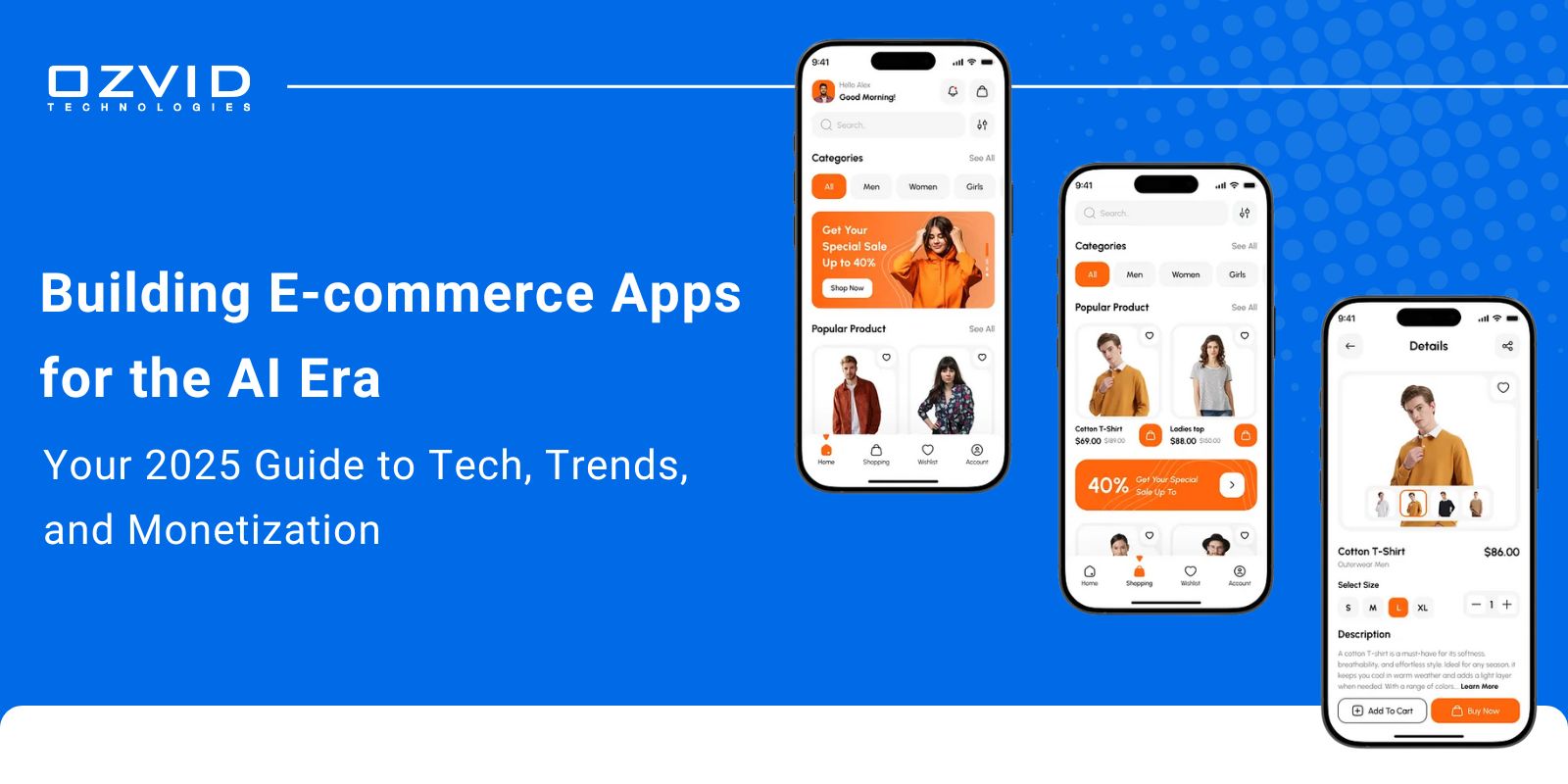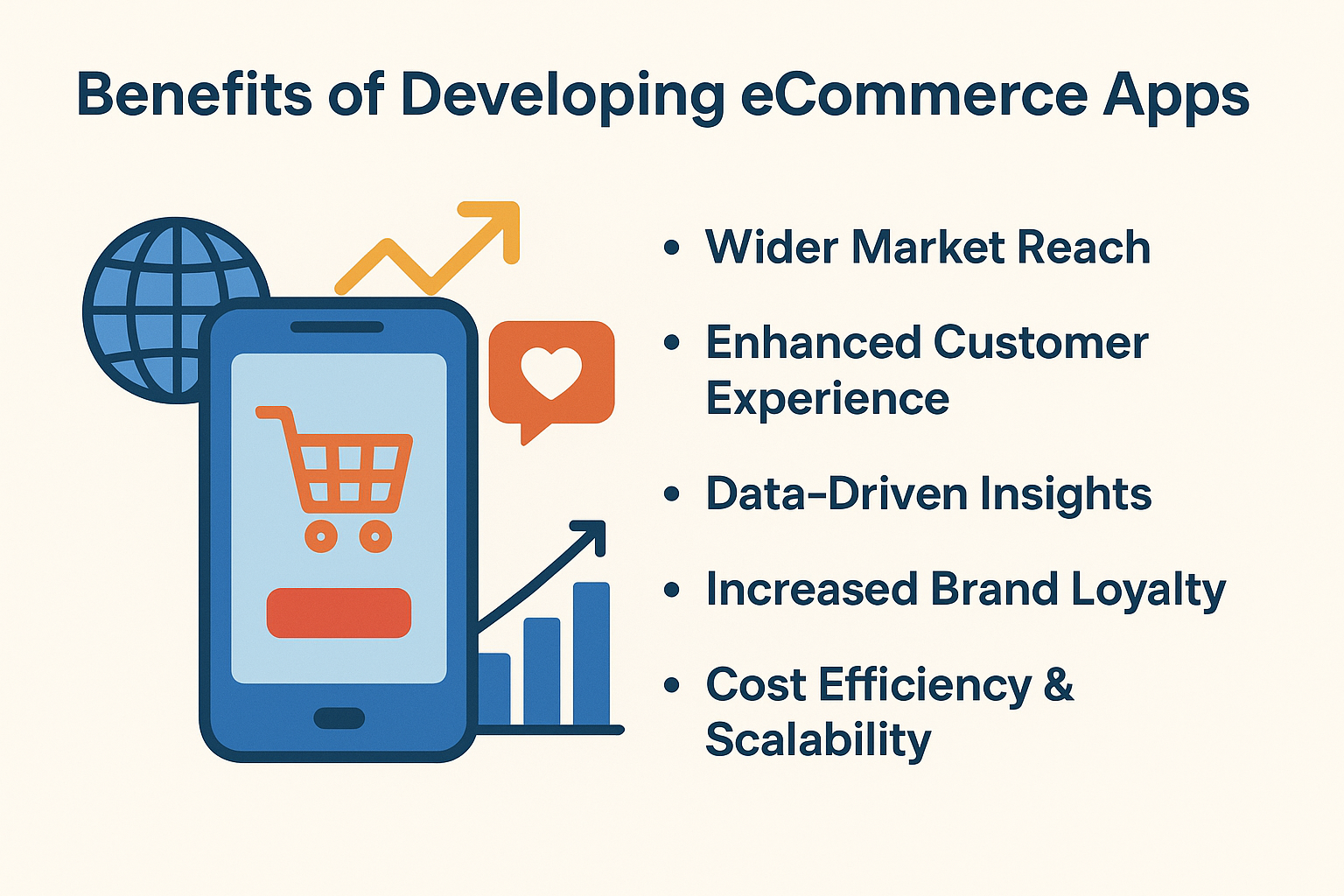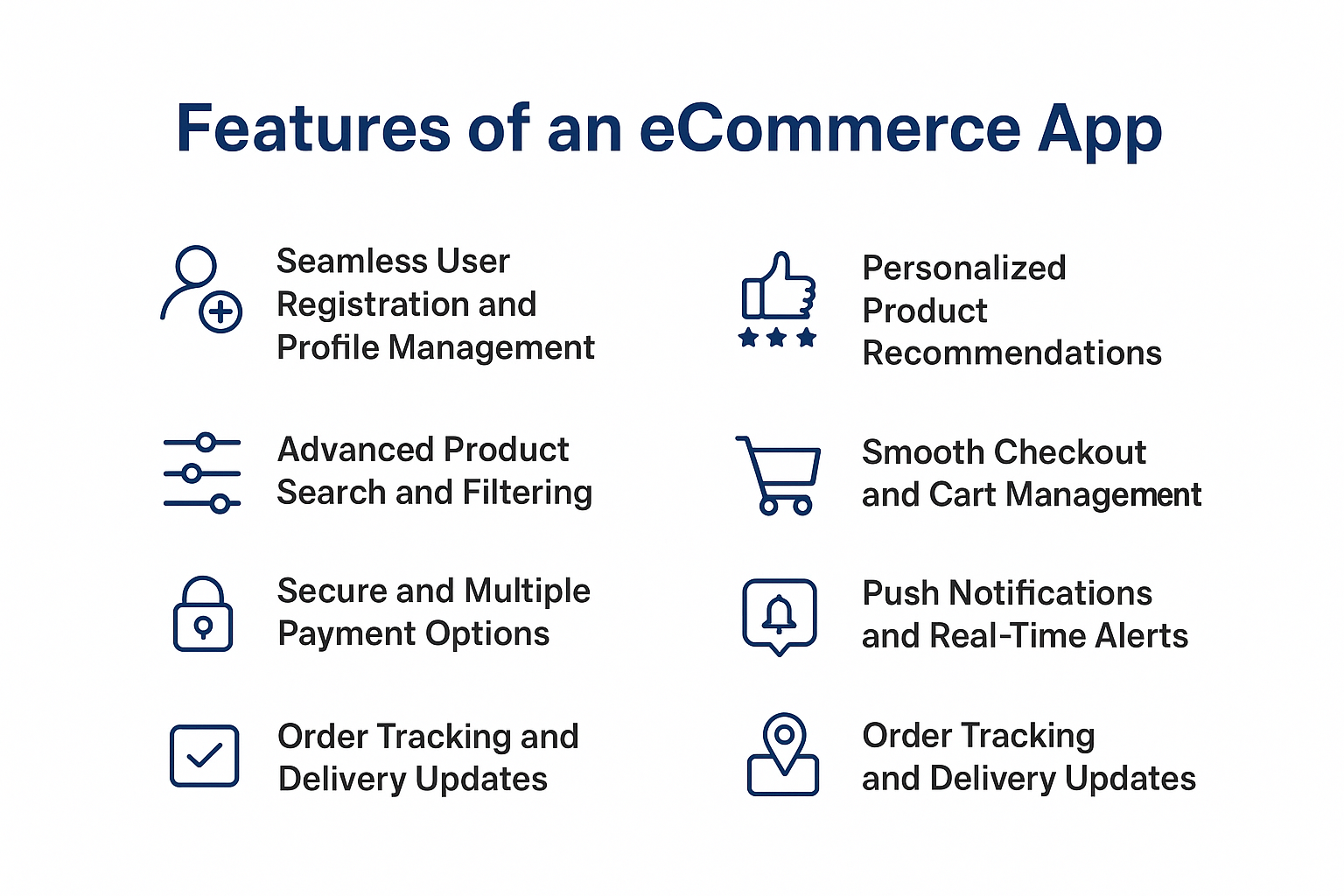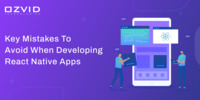- Aug 25, 2025
Share this post on:

Did you know the eCommerce market revenue is projected to hit US$3.66 trillion in 2025? It is expected to grow at an annual rate (CAGR 2025–2030) of 6.29%, reaching a market volume of approximately US$4.96 trillion by 2030. The way customers discover, evaluate, and purchase products has transformed dramatically in the past few years, and it’s accelerating in 2025. Speed, convenience, and personalization are no longer “nice to have”, they are the baseline. For brands and retailers, the eCommerce app has become the most effective vehicle to deliver this modern, always-on experience. As OZVID Technologies, we build applications that go beyond a digital storefront. We architect intelligent buying journeys powered by data, automation, and AI so that every interaction moves customers closer to purchase with confidence.
This complete guide shares what we have learned from building eCommerce apps for startups, direct-to-consumer brands, and large businesses. You will find practical insights on the market, the role of AI, app types, benefits, development steps, eCommerce app features, the recommended technology stack, costs, and the latest trends shaping 2025. Whether you are launching your first eCommerce application or scaling a mature eCommerce mobile app, use this playbook to plan, build, and monetize with clarity.
Key Takeaways
- E-commerce apps boost business growth by offering seamless, personalized shopping experiences.
- Different types of e-commerce apps cater to diverse business models and customer needs.
- Essential features like secure payments, easy navigation, and personalization drive user engagement.
- Development cost varies based on features, complexity, and chosen platform.
Importance of AI in eCommerce Apps
Artificial Intelligence (AI) has become a game-changer in the eCommerce industry, reshaping how businesses connect with customers and how users shop online. Integrating AI in eCommerce apps is essential for improving customer experience, increasing efficiency, and driving growth. Here are five key reasons why AI is so important in eCommerce app development:
1. Personalized Shopping Experiences
AI analyzes user data such as browsing history, preferences, and purchase patterns to deliver personalized recommendations. Customers receive product suggestions tailored to their interests, making their shopping journey smoother and more engaging. This not only increases customer satisfaction but also boosts sales and builds long-term loyalty.
2. Smart Search and Discovery
AI-powered features like voice search, image recognition, and predictive search make it easier for users to find products quickly. By understanding customer intent, AI ensures relevant results, improving product discovery and reducing the time spent searching. This enhances overall user experience and increases conversion rates.
3. AI Chatbots and Virtual Assistants
AI chatbots provide 24/7 customer support, answering queries, assisting with orders, and even recommending products. They enhance user engagement by offering instant responses while reducing dependency on human support. Over time, these virtual assistants learn from customer interactions, becoming more efficient and delivering a seamless support experience.
4. Fraud Prevention and Security
AI algorithms detect unusual purchase behaviors and suspicious activities, helping businesses prevent fraud and ensure secure transactions. From payment security to account protection, AI safeguards both customers and businesses, creating a trustworthy eCommerce environment that builds customer confidence.
5. Inventory and Demand Forecasting
AI helps businesses manage inventory effectively by predicting demand based on customer trends and market patterns. This minimizes stockouts and overstock issues, ensuring products are available when customers need them. Optimized inventory management also improves supply chain efficiency and reduces operational costs.
Types of eCommerce Apps Businesses Build
1. Business-to-Consumer (B2C) eCommerce Apps
B2C apps connect businesses directly with end-users, enabling product browsing, price comparison, and seamless purchasing. Features like secure payments, quick checkouts, and personalized recommendations enhance customer satisfaction, making platforms like Amazon or Walmart the most popular examples worldwide.
2. Business-to-Business (B2B) eCommerce Apps
B2B eCommerce apps serve businesses dealing with bulk orders, wholesale pricing, and supply chain operations. They simplify large-scale transactions, streamline processes, and improve vendor relationships. Alibaba stands as a prime example of successful B2B mobile commerce apps.
3. Consumer-to-Consumer (C2C) eCommerce Apps
C2C platforms enable individuals to buy and sell directly to each other. Apps like eBay or OLX allow users to list products, connect with buyers, and complete transactions, focusing on trust, security, and convenient user experiences.
4. Consumer-to-Business (C2B) eCommerce Apps
C2B apps allow individuals to offer services or products to businesses. Freelancing platforms like Fiverr or Upwork showcase how professionals connect with organizations. Features like ratings, transparency, and secure payments are essential for building credibility in this model.
5. Marketplace eCommerce Apps
Marketplace apps host multiple vendors under one platform, offering a wide range of products. Apps like Etsy or Flipkart manage seller accounts, inventories, and customer service efficiently, giving customers variety while helping sellers expand their digital presence.
6. Subscription-Based eCommerce Apps
Subscription models provide recurring services or products through apps. Netflix and Dollar Shave Club exemplify this approach. Success depends on retaining customers through flexible plans, exclusive offers, and personalized content tailored to user preferences and convenience.
7. On-Demand eCommerce Apps
On-demand apps like UberEats or Instacart cater to instant needs, offering real-time services and deliveries. Features like GPS tracking, instant notifications, and secure payments drive convenience, making these apps a fast-growing sector in the digital economy.
8. Social Commerce Apps
Social commerce apps integrate shopping with social media platforms like Instagram Shopping or TikTok Shops. They leverage influencer marketing and engaging content to convert browsing into purchases, offering users seamless in-app discovery and checkout experiences.
9. Niche eCommerce Apps
Niche apps focus on specific markets such as eco-friendly products, pet care, or handmade crafts. By targeting unique audiences, they build loyal communities with personalized offers, reviews, and features that enhance customer trust and brand value.
Benefits of Developing eCommerce Apps

Wider Market Reach
eCommerce apps break geographical boundaries, allowing businesses to reach customers worldwide. With mobile devices being widely accessible, companies can expand their customer base, increase visibility, and tap into international markets without relying solely on physical stores.
Enhanced Customer Experience
Personalized recommendations, easy navigation, and secure payments make eCommerce mobile apps user-friendly. Features like push notifications, live chat, and order tracking enhance convenience, ensuring a seamless shopping journey that boosts customer satisfaction and long-term loyalty.
Data-Driven Insights
eCommerce apps collect valuable customer data, including browsing history, purchase patterns, and feedback. Businesses can leverage this data to make informed decisions, improve marketing strategies, and deliver more personalized experiences, ultimately driving higher engagement and conversion rates.
Increased Brand Loyalty
By offering loyalty programs, discounts, and exclusive offers, mobile Commerce apps strengthen customer relationships. Regular engagement through personalized push notifications keeps customers connected to the brand, helping businesses build trust and long-term customer retention.
Cost Efficiency & Scalability
eCommerce apps reduce overhead costs compared to physical stores, eliminating expenses like rent and extra staff. With cloud-based systems and AI-powered automation, businesses can scale operations efficiently while maintaining profitability and growth potential.
How to Develop an eCommerce App
Developing an eCommerce app is a structured process that requires careful planning, the right technology stack, and a strong focus on customer experience. Each stage plays a vital role in ensuring that the app is user-friendly, secure, and scalable.
1. Define Business Objectives and Target Audience
Before starting development, businesses must clearly define their goals, whether it’s driving sales, improving customer loyalty, or expanding into new markets. Understanding the target audience’s shopping habits, preferences, and challenges ensures the app is tailored to user needs and delivers real value.
2. Conduct Market Research and Competitor Analysis
Thorough market research helps identify industry trends, customer expectations, and potential gaps in the market. Competitor analysis reveals which eCommerce app features are working and what improvements can be made, allowing businesses to design an app that stands out in a competitive marketplace.
3. Choose the Right Type of eCommerce Application
Businesses must select the most suitable type of eCommerce application, B2C, B2B, C2C, or subscription-based, depending on their target audience and offerings. The chosen model impacts the design, features, and monetization strategy, making it a crucial step in app planning and development.
4. Decide on Features and Functionality
Defining essential features such as user registration, product search, shopping cart, secure payment gateways, and AI-powered recommendations is vital. Advanced functions like AR/VR previews, chatbots, and push notifications can further enhance customer engagement and create a more personalized shopping experience.
5. Select the Right Technology Stack
The app’s success depends heavily on the technology stack chosen for development. For mobile commerce app development, businesses need a strong backend (Node.js, Python, Ruby), frontend frameworks (React Native, Flutter), and reliable databases (MySQL, MongoDB) for speed, scalability, and security.
6. Focus on UI/UX Design
A user-friendly design is the backbone of a successful eCommerce mobile app. Clean navigation, attractive visuals, and smooth checkout processes reduce cart abandonment. A responsive design ensures the app functions well on all devices, giving customers a seamless shopping experience.
7. Develop a Minimum Viable Product (MVP)
Launching an MVP allows businesses to test core features before full-scale development. It helps gather customer feedback, understand user behavior, and make improvements. This step reduces risks, saves costs, and ensures the final app aligns with customer expectations.
8. Integrate Secure Payment Gateways
Trust is essential in eCommerce app development. Integrating secure and multiple payment options—credit cards, digital wallets, UPI, or buy-now-pay-later systems, ensures smooth transactions. Implementing fraud detection and encryption builds customer confidence in using the app for regular purchases.
9. Incorporate AI and Advanced Technologies
AI in eCommerce app development has become essential in 2025. Features like smart search, personalized recommendations, voice shopping, and AI chatbots improve customer experience. Integration of AR for product visualization and ML-driven analytics makes the app future-ready and competitive.
10. Testing and Quality Assurance
Extensive testing ensures that the app runs smoothly without bugs or glitches. Performance testing, security testing, and usability testing help detect issues before launch. QA also ensures the app can handle high traffic volumes during sales and promotional events.
11. Launch and App Store Optimization (ASO)
Once development and testing are complete, the app is launched on app stores. Proper App Store Optimization (ASO) strategies such as keyword-rich titles, descriptions, and high-quality visuals help the app gain visibility, attract downloads, and reach the target audience.
12. Post-Launch Support and Updates
The development process doesn’t end at launch. Regular updates, bug fixes, and new feature additions ensure long-term success. Continuous monitoring of customer feedback and app analytics helps improve functionality, keeping the app competitive and relevant in a rapidly evolving market.
Features of an eCommerce App
Building a successful eCommerce application requires integrating features that enhance user experience, simplify navigation, and drive sales. Each feature plays a role in ensuring smooth operations and customer satisfaction. Below are some essential eCommerce app features that businesses must consider:

1. Seamless User Registration and Profile Management
A smooth onboarding experience is vital to retain users. Offering multiple sign-up options such as email, phone, or social media logins helps users quickly create profiles. Once registered, profile management should allow them to update information, track orders, save payment methods, and manage preferences conveniently.
2. Advanced Product Search and Filtering
Customers expect to find products instantly. Incorporating AI-powered search with autocomplete, voice search, and personalized suggestions improves discoverability. Filters based on size, color, price, brand, and ratings help users narrow down options quickly, reducing the time it takes to find their desired product.
3. Secure and Multiple Payment Options
Payments are the most critical aspect of any eCommerce mobile app. To build trust, the app must provide multiple payment gateways such as credit/debit cards, digital wallets, UPI, net banking, and even “buy now, pay later” options. Adding strong encryption and PCI-DSS compliance ensures customer data security during transactions.
4. Personalized Product Recommendations
AI in eCommerce app development enables highly tailored experiences by analyzing browsing history, purchase behavior, and preferences. Personalized recommendations keep users engaged, increase average order value, and improve customer retention rates by showing them products they are most likely to purchase.
5. Smooth Checkout and Cart Management
A long or complicated checkout process often leads to abandoned carts. Streamlined cart management, one-click checkout, saved addresses, and multiple delivery options reduce friction. Features like guest checkout and order summary reviews also make the process more user-friendly and efficient.
6. Push Notifications and Real-Time Alerts
Push notifications help businesses keep users engaged with timely updates on discounts, new arrivals, abandoned carts, and order tracking. However, they should be personalized and relevant to avoid overwhelming the customer. Real-time alerts build trust by keeping customers informed about their orders.
7. Order Tracking and Delivery Updates
Modern eCommerce applications provide real-time order tracking integrated with GPS. Customers can monitor every stage of delivery, from dispatch to doorstep, ensuring transparency. Features like estimated delivery time, delivery partner contact, and instant status updates significantly enhance customer satisfaction.
8. Ratings, Reviews, and Social Proof
User-generated content such as ratings and reviews plays a huge role in purchase decisions. Allowing customers to rate products, upload images, and share feedback builds credibility and helps new buyers make informed choices. Verified reviews act as social proof, strengthening customer trust in your platform.
9. Multilingual and Multi-Currency Support
For businesses targeting global audiences, eCommerce applications must provide multilingual support and accept multiple currencies. This feature ensures inclusivity, eliminates language or currency barriers, and allows businesses to cater to diverse markets without friction.
10. AI-Driven Chatbots and Customer Support
Customer support is crucial in mobile commerce app development. AI chatbots provide 24/7 support, answering FAQs, assisting in order tracking, and resolving minor issues instantly. For complex problems, users can connect directly to a live support agent, ensuring that customer service remains responsive and reliable.
Technology Stack to Create an eCommerce App
Front-end
- Native: Swift/SwiftUI (iOS), Kotlin/Jetpack Compose (Android) for top performance and deep device access.
- Cross-platform: Flutter and React Native for shared codebases and faster releases—excellent for MVPs and feature parity.
Back-end & Commerce Engine
- Headless commerce with modular services for catalog, checkout, and orders.
- APIs/GraphQL for efficient data fetching to mobile clients.
- Databases: transactional (e.g., Postgres) plus analytics warehouse (e.g., BigQuery/Snowflake).
AI/ML
- Recommendation services, search ranking models, pricing elasticity models.
- NLP for chat, support summarization, and content generation.
- MLOps: feature stores, model versioning, monitoring for drift and fairness.
Integrations
- Payments: gateways, wallets, BNPL providers.
- Logistics: shipping aggregators, last-mile carriers.
- MarTech: CDP, ESP, push providers, analytics, attribution.
DevOps & Quality
- CI/CD with automated builds, tests, linting, and store deployments.
- Observability: logs, metrics, traces; crash and performance monitoring.
- Security: secret management, SAST/DAST, compliance checks.
Cost to Develop an eCommerce App
Developing an eCommerce app is a significant investment, and the cost depends on various factors such as features, design complexity, platforms, and development approach. Businesses must carefully analyze these aspects before starting development to align with their budget and goals. Below are the major cost-influencing factors:
1. App Complexity and Features
The number and type of features included in your eCommerce app have the biggest impact on the budget. A basic app with limited features like product listings, cart, and payment gateway will cost less, whereas a fully advanced app with AI-driven personalization, AR-based product previews, and multi-language support will require more development time and higher investment.
2. Platform Choice (iOS, Android, or Cross-Platform)
Whether you choose to build your app for iOS, Android, or both will affect the total cost. Developing native apps separately for iOS and Android is usually more expensive than cross-platform solutions. However, native apps often provide better performance and user experience, while cross-platform frameworks can reduce costs but may have limitations in scalability.
3. Design and User Experience (UI/UX)
A simple design may cost less, but in today’s competitive market, a visually appealing and highly intuitive user experience is crucial. Customized UI/UX design with animations, interactive elements, and smooth navigation requires more time and expertise, increasing the development cost but also significantly improving user engagement and retention.
4. Development Team Location and Expertise
The location of your development team greatly influences the overall app development cost. Hiring developers in North America or Europe is usually more expensive compared to regions like Asia, where development rates are more affordable. Additionally, working with an experienced eCommerce app development company will cost more but ensures quality, scalability, and long-term support.
5. Third-Party Integrations
Integrations such as payment gateways, shipping APIs, CRM systems, chatbots, or advanced analytics tools add extra functionality but also increase costs. Each integration requires development, testing, and maintenance to ensure smooth performance, which contributes to the overall budget.
6. Maintenance and Updates
Development costs don’t end with launching the app. Regular updates, bug fixes, server management, and introducing new features are crucial to keeping the app secure and competitive. Businesses should allocate at least 15–20% of the total budget annually for ongoing maintenance.
On average, the cost to develop an eCommerce app can range from $15,000 to $50,000 for a basic app, while highly advanced apps with cutting-edge features may exceed $100,000 or more depending on the requirements.
App Type | Key Features | Estimated Cost (USD) | Development Timeline |
|---|---|---|---|
Basic App | Product catalog, search & filter, cart, checkout, secure payment gateway | $15,000 – $30,000 | 2 – 4 months |
Medium App | Advanced search, push notifications, multiple payment gateways, user profiles, order tracking | $30,000 – $60,000 | 4 – 6 months |
Advanced App | AI-driven recommendations, AR/VR product view, real-time analytics, multi-language, chatbot support, loyalty programs | $60,000 – $100,000+ | 6 – 12 months |
Latest Trends in eCommerce App Development
The eCommerce industry is evolving rapidly, and businesses need to keep up with the latest technological innovations to stay competitive. Modern customers expect personalized, seamless, and secure shopping experiences, and advancements in eCommerce app development are enabling businesses to deliver exactly that. Here are the latest trends shaping the future of eCommerce mobile apps in 2025:
1. AI-Powered Personalization
Artificial Intelligence in eCommerce is revolutionizing how businesses engage with customers. By analyzing user behavior, purchase history, and browsing patterns, AI in eCommerce app development helps brands deliver personalized recommendations, dynamic pricing, and predictive search results. This not only enhances customer satisfaction but also boosts conversions and repeat purchases.
2. Voice Commerce and Smart Assistants
Voice-enabled shopping is becoming a mainstream trend with the rise of devices like Amazon Alexa, Google Assistant, and Siri. An eCommerce mobile app integrated with voice search allows users to place orders, check product availability, and track deliveries using voice commands, making the shopping experience faster and more convenient.
3. Augmented Reality (AR) and Virtual Try-Ons
Customers want to visualize products before making a purchase, and AR/VR integration in eCommerce applications makes this possible. From trying on clothes and accessories virtually to checking how furniture looks in a living room, AR-based features help reduce product returns and improve customer trust.
4. Mobile Wallets and Seamless Payments
With the growing demand for mobile commerce app development, secure and fast payment options are now essential. Integrating wallets like Apple Pay, Google Pay, and PayPal, along with multiple gateways, ensures quick checkout and improves customer retention. The trend of one-click payments is expected to dominate in 2025.
5. Social Commerce Integration
Social media platforms are no longer just marketing channels, they have become active shopping platforms. Integrating an eCommerce app with Instagram Shops, Facebook Marketplace, and TikTok Shopping allows businesses to reach wider audiences and convert social interactions directly into sales.
6. AI-Powered Chatbots and Virtual Assistants
Modern eCommerce apps are increasingly using AI chatbots to provide real-time assistance, handle FAQs, and guide customers through the buying process. This reduces dependency on human support teams, ensures 24/7 availability, and provides a smooth customer journey from product discovery to checkout.
7. Hyper-Personalized Push Notifications
Push notifications are evolving beyond generic promotional messages. In 2025, eCommerce application development is focusing on hyper-personalized alerts that use AI and behavioral analytics to send tailored product recommendations, price-drop alerts, and restock notifications to specific users, increasing engagement rates.
8. Omnichannel Shopping Experience
Customers expect a seamless shopping journey across mobile apps, websites, and physical stores. Omnichannel commerce integration ensures that users can browse products online, check in-store availability, and pick up items from nearby outlets. This trend creates consistency across multiple touchpoints and builds brand loyalty.
9. Blockchain for Secure Transactions
Security is one of the biggest concerns in online shopping. With blockchain integration in eCommerce applications, businesses can offer decentralized and tamper-proof transactions, ensuring customer trust while protecting sensitive payment and personal data.
10. Subscription-Based Models and Loyalty Programs
The subscription economy is booming, and businesses are incorporating subscription plans within eCommerce apps to ensure recurring revenue. Loyalty programs with gamified features also encourage repeat purchases and increase customer lifetime value.
Also Read: How Much Does It Cost to Build a Quick Commerce App Like Blinkit?
Why Choose OZVID Technologies for eCommerce App Development
Choosing the right partner is the single most important decision you’ll make after validating your business model. Here is how OZVID approaches mobile commerce app development to de-risk and accelerate outcomes:
1. Proven Experience and Industry Knowledge
OZVID Technologies brings years of expertise in building eCommerce apps tailored to different industries, whether it’s retail, fashion, food, or healthcare. The team understands the challenges businesses face and delivers customized solutions that align with market trends and consumer behavior. This strong foundation helps brands launch apps that are not only functional but also competitive.
2. Cutting-Edge Technology Integration
The company stays ahead of the curve by incorporating the latest technologies into its solutions. From AI-powered personalization and chatbots to AR/VR shopping experiences, blockchain-secured payments, and IoT-based inventory management, OZVID ensures every app is future-ready and designed to enhance customer satisfaction.
3. User-Centered Design Approach
A successful eCommerce app must be engaging, intuitive, and easy to navigate. OZVID focuses on creating user-friendly interfaces with seamless navigation, quick loading speed, and secure checkouts. This design-first approach not only improves customer experience but also boosts conversions and long-term customer loyalty.
4. Agile Development and Ongoing Support
OZVID follows an agile methodology that emphasizes collaboration, transparency, and flexibility. Clients are involved at every stage of development, ensuring faster delivery and better outcomes. Even after launch, the company provides continuous support, updates, and performance monitoring to keep apps secure, efficient, and up-to-date.
5. Cost-Effective and Scalable Solutions
Every business has unique requirements and budgets. OZVID offers scalable solutions with transparent pricing models, making it possible for startups and enterprises alike to invest confidently. As businesses grow, their apps can expand seamlessly without the need for complete redevelopment, saving time and costs in the long run.
Conclusion
The eCommerce landscape in 2025 rewards brands that combine flawless execution with intelligent, data-driven experiences. An eCommerce mobile app is the centerpiece of that strategy, where your merchandising, content, service, and operations converge into a customer journey that feels effortless and personal. Building it well requires clarity on market forces, mastery of the craft, and a partner who can translate goals into outcomes.
At OZVID Technologies, eCommerce app development is a discipline we’ve honed across industries and growth stages. As an eCommerce app development company, we deliver apps that are fast, secure, and deeply personalized, with architectures that scale and evolve. Whether you’re planning your first eCommerce application or modernizing a legacy stack, we can help you define a roadmap, choose the right technology, and launch with confidence.
If you’re ready to turn your vision into a roadmap, and your roadmap into a business-driving app, let’s build it together. OZVID Technologies is your partner for mobile commerce app development, from strategy and design to engineering, AI, and growth. Contact us today.
FAQ's
1. How does AI improve the performance of an eCommerce app?
AI enhances eCommerce apps by offering personalized recommendations, intelligent search, predictive analytics, and automated customer support, resulting in higher engagement and improved sales conversion.
2. What are the top monetization strategies for eCommerce apps in the AI era?
Popular strategies include in-app advertising, subscription models, affiliate marketing, freemium upgrades, and AI-powered product recommendations that increase upselling opportunities and recurring revenue streams.
3. How much time does it usually take to develop a full-featured eCommerce app?
The development timeline depends on complexity; a basic app may take 3–5 months, while advanced AI-powered solutions may require 6–9 months or more.
4. How do eCommerce apps integrate with existing ERP or CRM systems?
Seamless integration is achieved using APIs and middleware solutions that connect inventory, customer data, and order management, ensuring synchronization across business operations.
5. What role does machine learning play in eCommerce mobile app development?
Machine learning enhances fraud detection, dynamic pricing, demand forecasting, and product recommendations, making apps smarter and more efficient for both businesses and customers.










